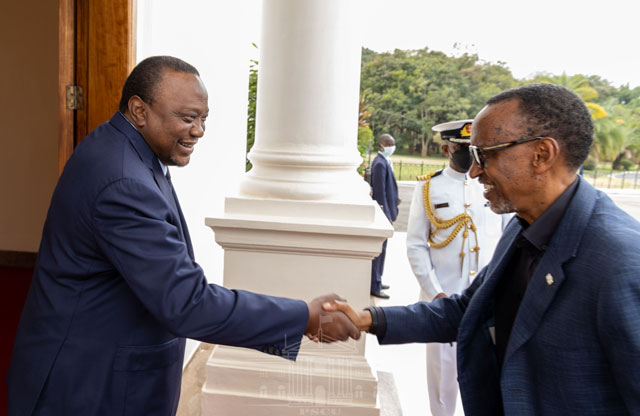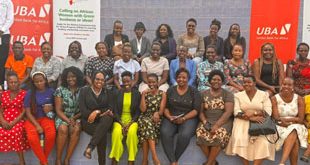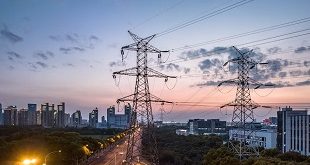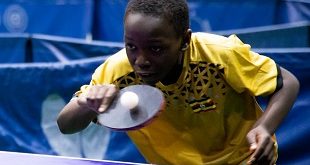
Nairobi, Kenya | THE INDEPENDENT & XINHUA | Kenya’s President Uhuru Kenyatta has today hosted the EAC Heads of State Conclave on Inter-Congolese Dialogue of the Nairobi Process on the Peace and Security Situation in Eastern DR Congo.
Today’s Heads of State high-level meeting hosted by Chairperson of EAC, is an acceleration of ongoing regional efforts to attain sustainable peace and security in Eastern DR Congo
In attendance were East African Community (EAC) counterparts Yoweri Museveni (Uganda), Paul Kagame (Rwanda), Evariste Ndayishimiye (Burundi), Salva Kiir Mayardit (South Sudan) and Felix Tshisekedi (DR Congo) at State House. President Samia Suluhu Hassan of Tanzania was represented at the meeting by the country’s ambassador to Kenya, High Commissioner John Stephen Simbachawene.
It comes after a week of rising tension in eastern DRC, with the government accussing Rwanda of supporting M23 rebels.
The UN Stabilization Mission in the Democratic Republic of the Congo (DRC) on Sunday condemned new targeted attacks on several of its positions by rebels of the March 23 Movement (M23).
Several positions of the mission were hit Sunday by at least six mortars in the Shangi area of the northeastern North Kivu province, according to the mission.
Attacks targeting UN peacekeepers “can constitute a war crime under international law,” the top UN envoy in the DRC tweeted via the mission’s Twitter account.
The mission also promises to continue all possible efforts to protect civilians and help deliver needed assistance to displaced populations, according to the tweets.
Since late March, M23 has been on the offensive in the North Kivu province, with thousands of civilians displaced by ongoing fighting.
Kenyan President Kenyatta has called for an immediate deployment of a new regional military force led by the EAC to try to stop rebel violence in eastern DRC.
The rebel group announced in early April its withdrawal from the villages it had taken earlier in the Rutshuru territory.
The group consists of former rebels of the National Congress for the Defense of the People (CNDP) and got its name from the March 23, 2009 agreement between the CNDP and the Congolese government.
M23 leaders have accused the government of failing to respect the agreement.
 The Independent Uganda: You get the Truth we Pay the Price
The Independent Uganda: You get the Truth we Pay the Price



How Do you Solve a Problem like Congo….
By the mention of the Congo, two adages come to life 1.) That greedy folks have long arms and
2.) That there’s honour among thieves….
The Congo conflict can not be seen under the narrow prisms of binary distinction…between the dominant and the dominated but rather a triangular relationship of namely; the perpetrator, the victim and the rescuer provides a wider view and better understanding of the nature and pattern of the Congo conflict. ….
Congo (DRC) measures about 2.3million square kilometres in land size and underneath it, sits more than $24 trillion worth of natural resources including, 3.2trillion cubic feet of natural gas. This makes Congo the single most wealthiest nation on the planet. However, Congo is also home to the world’s poorest, as more than 63% of the population lives below the poverty line.
It’s also noteworthy, that since the 2nd World war, the Congo conflict has been so far the bloodiest. In 2005, the International Rescue Committee reported that the war in Congo claimed 1,000 lives per day!
Today, in a definitive tale, following chronological historical events, this analysis will conclusively provide you with specific elements of the conflict taking into account the intricacies involved, highlighting and examining paternalism, greed and arrogance as agents that have continuously eroded away not only the trove of Congo’s gems but also negatively impacted on the national sense of confidence building.
Even when Congo hasn’t evolved on the economic front, it has however transited from conflict to conflict and from time to time. There seems to be a propinquity relationship between the Congo and war. Peace in the Congo seems to be the proverbial needle in haystacks. The story of Congo’s political instability traces as far back to the time of its independence. In 1959, Henri Cornelis the last governor of Congo had estimated that it would take another 30 years from then for Congo to be able to take care of its affairs, yet, Congo became independent of Belgium on 30th June, 1960. This was due in part, because of the ongoing war that was taking place in Algeria…in that, Belgium was spread thin, it could not take care of the war and at the same time contain the civil agitation of independence in Congo. There was always going to be something to give. But the circumstances under which she received her independence could be instructive to what became of the country. The Belgians had not trained native Congolese to become a local elite class that would take charge of their country, but rather a trained labour force that would suit their described jobs. Thus, at independence, there were only 16 graduates and an engineer would only emerge a year later in 1961. This speaks to the paternalistic relationship that the Congo had with its former colonial master. And on 30th June, 1960, Prime minister Patrice Lumumba did not miss his words when he echoed how “ironic” the marked Congolese independence was …. This did not go unnoticed by the Belgians, they became suspicious of Lumumba, he was now a marked a socialist/communist …they dreaded the possibility that he could “nationalise” powerful foreign companies including the famous Union Miniere du Haut Katanga (UMHK) and the Societe Generale… Due to these unfounded anxieties, the Belgians supported Moise Tshombe and on 11th July 1960, Katanga seceded from Congo and was declared independent. A month later…on 8th August, Kasai another province of Congo rich in diamond was also declared independent. Five months later…17th January, 1961, Patrice Lumumba was arrested and finally assassinated. The quick tragic flow of events follows the adapted strategic and tactical but rather conspicuous line of interference with which foreign players have acted in the Congo so as to disguise their involvement. We can assimilate to this fact when we talk of the 1966 crisis here in Uganda which was sparked off among other things by the tabling of the Daudi Ochieng motion. The motion accused Milton Obote then president and his army commander, Col. Idd Amin Dadda of their involvement in the gold scandal purportedly stolen from Congo. During this period, Congo plunged into civil strife to what is referred to as the “shaba wars” in reference to the mineral rich region of the Katanga. Private militias then took over the roles of the formal government authorities…. this was exacerbated by the formal withdraw of Belgium and other international players from the Congo which was occasioned by the collapse of the Soviet Union. Initially, western powers were concerned that the Soviets could use Congo as their base in the Great lakes region for communist purposes….but now that the threat had been extinguished, they saw no need for carrying on with the Congo burden….. With the massive exodus of the French troops, Belgian paras and Americans, the Congolese were now left to be on their own. The paroxysm effect of this retreat would later be a double whammy….. First, there followed statelessness that witnessed lootings, riots, and reckless killings within Congo which consequently would trigger the “official comeback” of foreign players but this time as “rescuers.” Secondly, Congo’s chequered political instability has had a domino effect on the whole of the Great lakes region. Following the excommunication of the Belgian Blue Helmets from the Congo, resulted in the murder of 10 Belgian soldiers in Rwanda which precipitated the 1994 Rwanda genocide. And this marked the beginning of another phase in the Congo conflict which has metamorphosed into an “inter-state” conflict now to include, Rwanda, Uganda, Burundi, South Africa, Angola, Zimbabwe, the Central African Republic and Congo.. phew!!! In the aftermath of the Rwandan genocide, the RPF leadership embarked on “dissolving” the remnants of the former Habyarimana army who had sought asylum in the thick forests of Eastern Congo. Miraculously, Uganda’s Museveni was aiming to “eliminate” the ADF who by natural coincidence also resided in Eastern Congo…..So, in 1997, Rwanda reinforced by the Ugandan army invaded Congo under the pretext of smoking out their respective rebels… however, the eyes reveal what always the heart conceals….they ended up toppling Mobutu and reinstalling Laurent Desire Kabila whom they toppled (Uganda & Rwanda) only a year later. Congo possesses two omens… its vastness in land size and its vast natural wealth…. metaphorically, Congo is a carcass in the face of hungry scavengers.. the Rwanda genocide was/is widely viewed as a local quarrel between the Hutu and the Tutsi jostling for political space… Taking into account what has played out in the last two decades, I want to believe otherwise…the problem in Rwanda is one of land…and spaces like Congo are considered a welcome solution. It is high time that world leaders perceived the Rwandan question as a global concern cause if it is mismanaged, it could spillover and turnout to be another “Israel.” The Great lakes region is infested with various global interests….. just as the Congo led to the scramble and partition of Africa…. just as Israel led to the 1st world war…. the Rwanda question if not well handled portends a catastrophe of such magnitudes…the Congo question calls for a holistic and honest discussion.
Rajab Kakyama